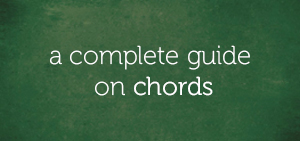I’ll be showing you six exercises on the major triad that I believe will help you in so many ways.
In the course of playing the kind of songs we do across genres like gospel, jazz, country, reggae, salsa, and many more others, we move from one major triad to the other. Consequently, knowing how to move major triads on the keyboard will give you an edge.
If you learn, memorize, and master these exercises and make them a part of your daily routine, you’ll improve your ability to play songs with tons of major chords with little or no difficulty.
An Overview Of The Major Triad And Its Inversions
The major triad is the chord of the first tone of the major scale.
Using the major scale in any key, you can derive the major triad by playing the first, third, and fifth tones together. Using the C major scale:
…you can derive the C major triad by playing the first, third, and fifth tones of the scale (which are C, E, and G):
So, “C-E-G” is the C major triad:
…and it’s called the C major triad because the first note (aka – “the root”) is C.
“Check Out All The Major Triads On The Keyboard…”
C major triad:
Db major triad:
D major triad:
Eb major triad:
E major triad:
F major triad:
Gb major triad:
G major triad:
Ab major triad:
A major triad:
Bb major triad:
B major triad:
The First Inversion Of The Major Triad
A triad consists of the first, third, and fifth tones of the major scale.
The lowest-sounding note in the major triad is usually the first tone and when a triad is played and the first tone is the lowest-sounding note, such a triad is said to be in root position.
When the third tone is the lowest-sounding note in a major triad, such a major triad is said to be played in its first inversion.
Attention: The inversion of a triad simply means a change in the order of the notes of a triad.
Changing the order of the notes of the C major triad from “C-E-G” to “E-G-C” produces the first inversion of the major triad:
C-E-G (root position):
E-G-C (first inversion):
In the first inversion of the C major triad (“E-G-C”):
…the lowest-sounding note of the C major triad is E:
The Second Inversion Of The Major Triad
When the fifth tone of a triad is its lowest-sounding note, such a triad is said to be played in its second inversion.
Using the C major triad (as a reference):
…when the fifth tone (which is G):
…is the lowest-sounding note, this produces “G-C-E” which is the second inversion of the C major triad:
“Now That We’ve Refreshed Our Minds On Major Triads…”
Let’s proceed into learning six exercises that would help you master major triads.
Exercises On The Major Triad
I need your active participation in this segment and if you have to stop reading now to get your hands on the piano, please do.
This segment has six exercises and I’ll love you to actually play them. So, get on the piano and let’s exercise our fingers using major triads on the keyboard.
Instruction: Each of the chords should be played to the beat; that is, one chord per beat or count. Also endeavor to start from a comfortable tempo before exercising with faster tempos.
Exercise #1 — “The Half-Step Movement”
1st count (C major triad):
2nd count (Db major triad):
3rd count (D major triad):
4th count (Eb major triad):
5th count (E major triad):
6th count (F major triad):
7th count (Gb major triad):
8th count (G major triad):
9th count (Ab major triad):
10th count (A major triad):
11th count (Bb major triad):
12th count (B major triad):
Attention: Feel free to play the given exercise using first inversion and second inversion chords.
Exercise #2 — “The Whole-Step Movement”
This exercise has two parts.
“Check Out The First Part…”
1st count (C major triad):
2nd count (D major triad):
3rd count (E major triad):
4th count (Gb major triad):
5th count (Ab major triad):
6th count (Bb major triad):
“Then The Second Part…”
1st count (Db major triad):
2nd count (Eb major triad):
3rd count (F major triad):
4th count (G major triad):
5th count (A major triad):
6th count (B major triad):
Attention: Feel free to play the given exercises (the first and second part) using first inversion and second inversion chords.
Exercise #3 — “The Fourth Movement”
1st count (C major triad):
2nd count (F major triad):
3rd count (Bb major triad):
4th count (Eb major triad):
5th count (Ab major triad):
6th count (Db major triad):
7th count (Gb major triad):
8th count (B major triad):
9th count (E major triad):
10th count (A major triad):
11th count (D major triad):
12th count (G major triad):
Exercise #4 — “The Fifth Movement”
1st count (C major triad):
2nd count (G major triad):
3rd count (D major triad):
4th count (A major triad):
5th count (E major triad):
6th count (B major triad):
7th count (F# major triad):
8th count (Db major triad):
9th count (Ab major triad):
10th count (Eb major triad):
11th count (Bb major triad):
12th count (F major triad):
Exercise #5 — “The Octatonic (W-H) Movement”
1st count (C major triad):
2nd count (D major triad):
3rd count (Eb major triad):
4th count (F major triad):
5th count (Gb major triad):
6th count (Ab major triad):
7th count (A major triad):
8th count (B major triad):
Exercise #6 — “The Octatonic (H-W) Movement”
1st count (C major triad):
2nd count (Db major triad):
3rd count (Eb major triad):
4th count (E major triad):
5th count (F# major triad):
6th count (G major triad):
7th count (A major triad):
8th count (Bb major triad):
Final Words
Now that you’ve played through all the exercises given in root position, I’ll want you to switch to the first and second inversions of the major triads given and repeat the same exercises.
I guarantee you that by the time you’re done, you’ll be absolutely grounded in major triads.
In a subsequent lesson, I’ll give you minor triad exercises that will help you to effortlessly master all the minor triads on the keyboard.
See you then!
Chuku Onyemachi
Latest posts by Chuku Onyemachi (see all)
- The Formation Of Diminished Seventh Chords Used To Be Challenging Until I Did This
- How To Form Seventh Chords In Two Shakes Of A Dog’s Tail Using Third Intervals And The Circle Of Fifths Chart
- I Played The 13sus4 Chord And This Happened…
- How To Build Seventh Chords Like An Architect Using “Foundation And Structure” Concept
- This 4-Week Plan Will Help You Master All The Major Scales







Comments on this entry are closed.